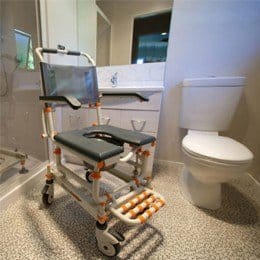How safe is your bathroom? Even those that do not currently have physical disabilities or mobility issues benefit from the safest bathroom possible; plus, a safer bathroom can reduce the risk of a nasty fall and injury. What does it take to make the bathroom safe? Start with a thorough inspection of the space, add some simple mobility solutions, and integrate common sense strategies.
It is said that most falls and subsequent injuries occur in the bathroom; if you think about it, this makes sense. After all, the bathroom is prone to being damp and slick underfoot- and rarely is this room of the house carpeted for extra tread. When a senior or someone with limited mobility takes a fall, the results can be catastrophic. Falls are to blame for the deaths of around 9,500 people each year in this country; seek out solutions, mobility aids, and equipment that will reduce this risk and help to keep you safe.
What type of mobility aids do you need to make the bathroom safe? Start here:
Grab on to Something
Start with something small but significant when making your bathroom safer: grab bars. Grab bars are no more than well-crafted handles that allow a firm hold that can stabilize and support as needed. These are inexpensive to buy and easy to install. Make sure to place them near the toilet, sink, and door- anywhere that could potentially offer benefit to the resident.
Sit Down
Buy an inexpensive shower seat for the tub or shower stall. These simply provide a stable, non-slip spot to sit while bathing which can be helpful for those that struggle with physical disabilities, pain, or vertigo- and could prevent a slip and fall that could be debilitating.
Need a Lift?
Depending on your needs, a lift can make using the bathroom much safer and accessible for those with physical limitations. There are a variety of lifts available from stair and vehicle lifts to freestanding lifts that can be moved around the home. A portable transport lift can help get an individual in and out of a tub or shower, while a stairlift may be all that is needed to provide access for the consumer to use their bathroom independently. Any way that you look at it, a lift can assist the user in getting to and using the bathroom in a safer, more secure way.
Raise the Seat
Simply raising the toilet seat a few inches can prevent a fall and a lot of problems- and it couldn’t be easier! There are some specifically designed devices that slip over the commode that raise the seat so the user does not need to bend all the way down to sit. Anyone with joint issues, arthritis pain, or knee problems will appreciate and be better able to use the toilet. This eliminates the need for assistance in getting up, too, in many cases; just make sure that there is a sturdy handrail accessible for those using the facility.
Forget the Frame
Frameless showers provide a smooth transition into the shower to bathe or wash, especially important for those that use any kind of mobility aid (i.e. wheelchair or walker) that can’t navigate the threshold of a conventional shower stall. There is no lifting of legs or maneuvering around to enter the shower- which may make it far more comfortable and accessible for a wide range of consumers to utilize. Talk to a mobility professional about the specifications and guidelines- or to learn more about making the shower safer.
Broaden the Berth
How is the entry and pathway going in and through the bathroom? Is the door wide enough to accommodate mobility aids, like walkers or wheelchairs? The ADA offers recommendations pertaining to the width and measurements of doors and facilities so refer to these if upgrading or renovating a bathroom to be more accessible.
A simple thing that anyone can do to make the bathroom safer for those coming in and out of it is to reduce the clutter and potential fall hazards that could be in plain sight. Simply look around and consider using the bathroom if you have a mobility issue or rely on mobility equipment; what are the challenges? Use this as a map to guide you in removing obstacles and creating a safer environment.
Never underestimate the importance and value of good lighting. This is particularly necessary in the bathroom, to prevent accidents and falls. While not a mobility aid, per se, investing in proper illumination is money well spent toward maintaining a safer bathroom- and home!
Is your bathroom as safe as it could be? Talk to the mobility professionals at Pacific Mobility to brainstorm and update your bathroom to be a safer environment for all who use it. Consider these tips when configuring and constructing your bathroom- and reduce the risks and complications associated with a nasty bathroom fall.
President, Husband, Father, Grandfather Graduate of UC Davis- Bio Sci Major- Go Aggies! Jeff has extensive experience in all of Pacific Mobility’s products and services, and specializes in accessibility products as well as stairlifts, ceiling lifts and custom wheel chairs. His hobbies include spending time with family, gardening, mountain biking, exercising and off road motorcycle riding.
24 years as Owner/President of Pacific Mobility Center – selling, installing, and servicing stairlifts, porch lifts, ceiling lifts, pool lifts, handicap ramping, specialty wheelchairs, scooters, power wheel chairs, and other power mobility devices
Certified Environmental Access Consultant since 2008
Licensed General Contractor since 1998
Certified Aging in Place Specialist since 2016
Board Member for Home Access Professionals
Member of Association of Members of the Accessibility Equipment Industry (AEMA)




